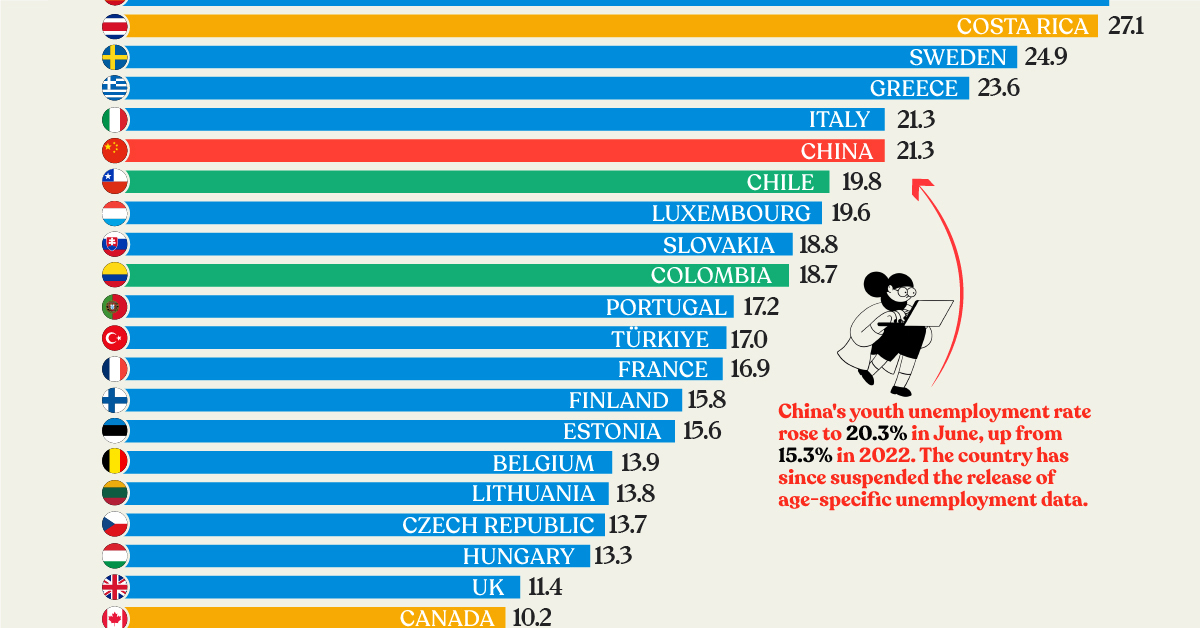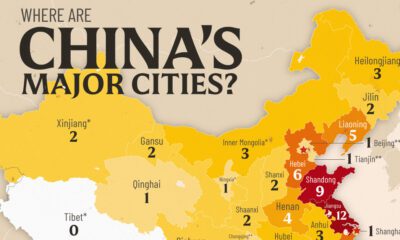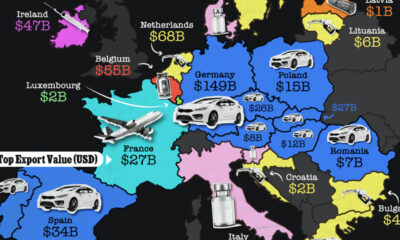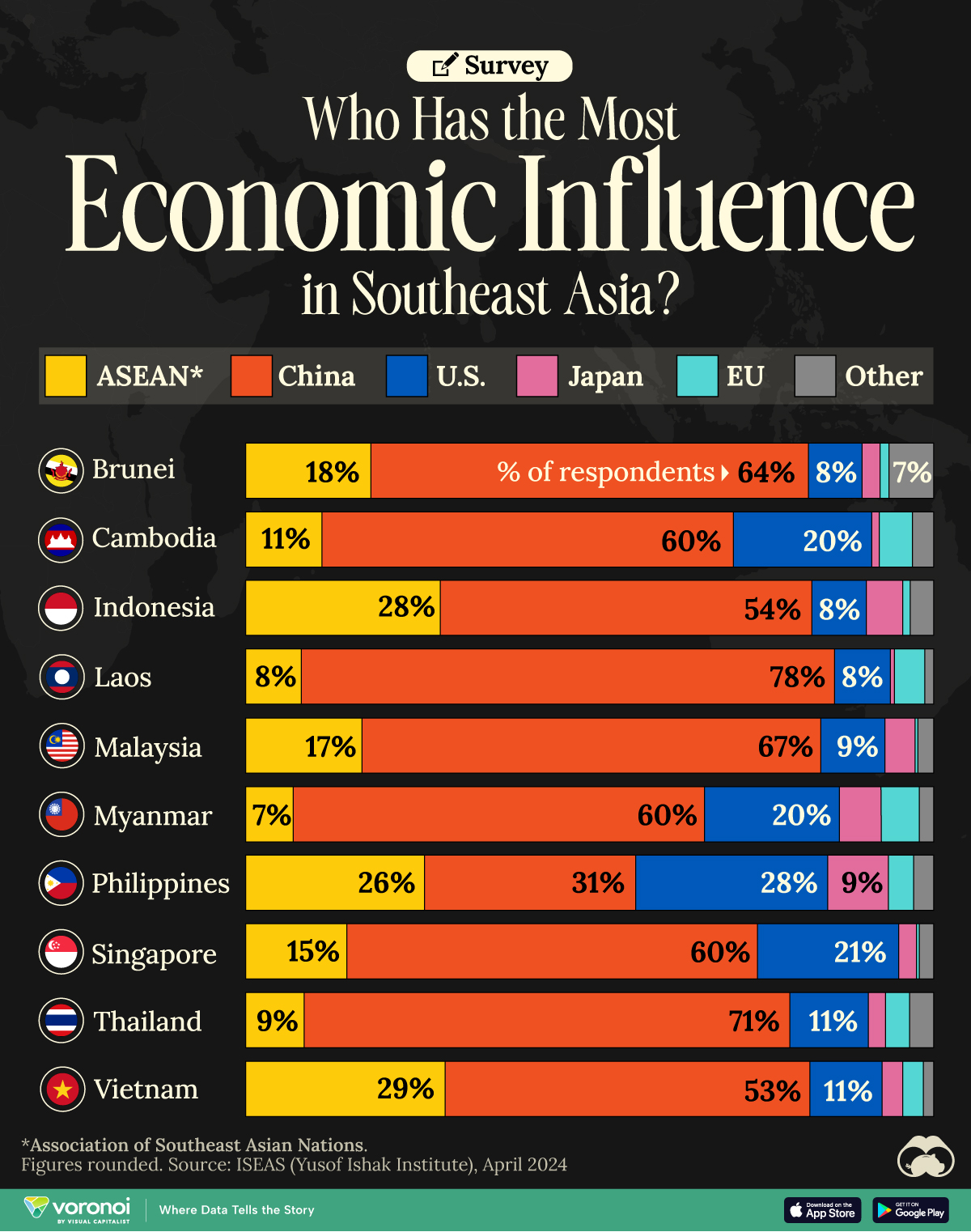China
Charted: Youth Unemployment in the OECD and China
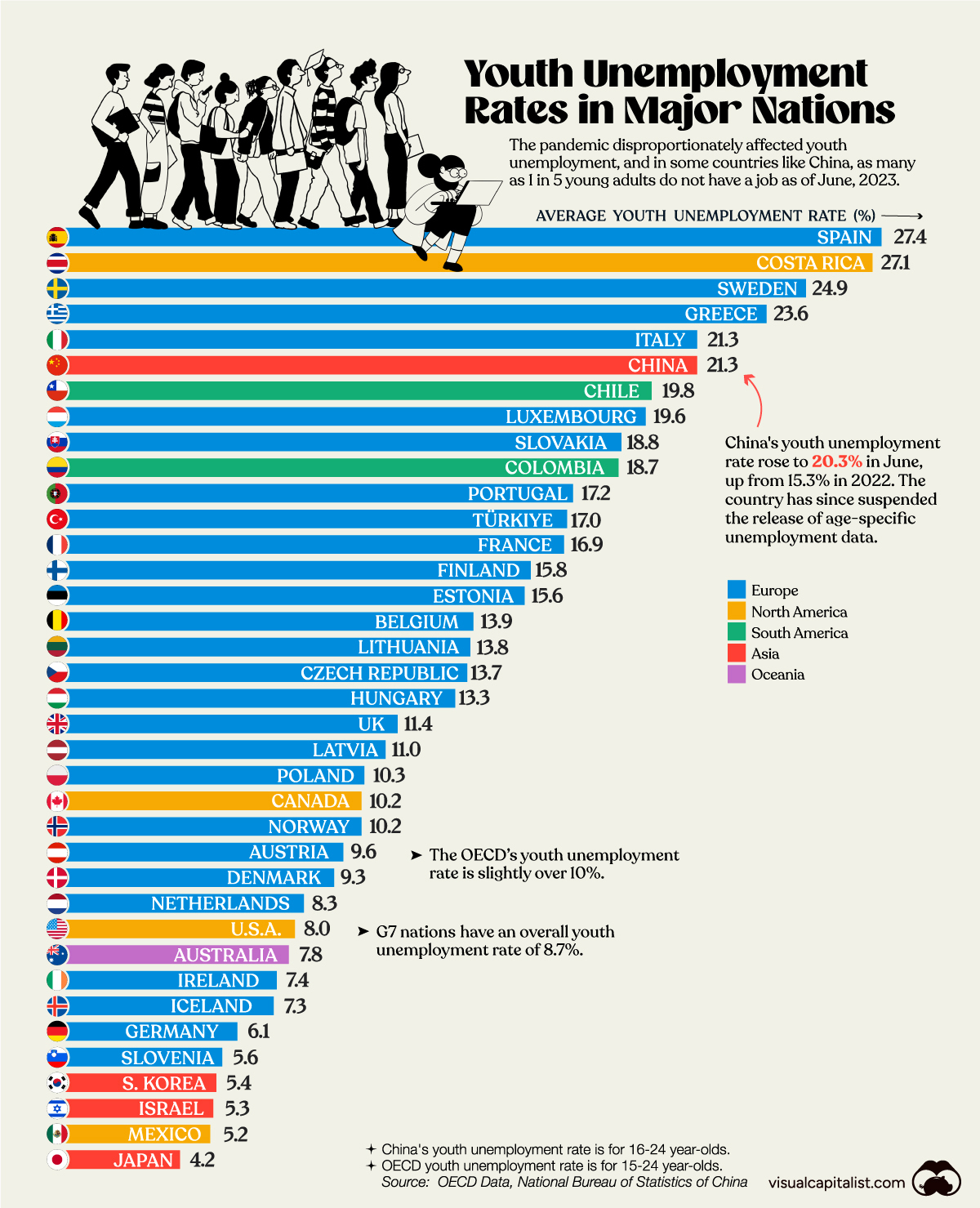
Charted: Youth Unemployment in the OECD and China
In nearly every country in the world, youth unemployment is much higher than general unemployment.
Unfortunately, the pandemic only exacerbated matters. During a crucial stretch of their early careers, young adults were locked out of entry-level jobs, destroying their ability to pick up work experience and potentially impacting their long-term earnings.
Now, nearly three years after COVID-19 first hit, young adults from some countries, like China, are struggling to find jobs. Using data from the OECD and the National Bureau of Statistics of China, we chart out the youth unemployment rate for 37 countries.
Ranked: Countries With the Highest Youth Unemployment
At the top of the list, Spain has the highest youth unemployment in the OECD, with nearly one in three young adults unable to find a job.
A mismatch between educational qualifications and the labor market has been cited as a significant reason for Spain’s lack of employed adults between the ages of 15–24.
Meanwhile, the country’s reliance on temporary contracts and dependence on seasonal sectors—like tourism—to generate jobs are some of the many reasons for its persistently high reported unemployment across demographic groups.
Listed below is the youth unemployment rate for all the OECD countries, and China, as of the second quarter of 2023.
| Rank | Country | Average Youth Unemployment Rate |
|---|---|---|
| 1 | 🇪🇸 Spain | 27.4% |
| 2 | 🇨🇷 Costa Rica | 27.1% |
| 3 | 🇸🇪 Sweden | 24.9% |
| 4 | 🇬🇷 Greece | 23.6% |
| 5 | 🇨🇳 China | 21.3% |
| 6 | 🇮🇹 Italy | 21.3% |
| 7 | 🇨🇱 Chile | 19.8% |
| 8 | 🇱🇺 Luxembourg | 19.6% |
| 9 | 🇸🇰 Slovakia | 18.8% |
| 10 | 🇨🇴 Colombia | 18.7% |
| 11 | 🇵🇹 Portugal | 17.2% |
| 12 | 🇹🇷 Türkiye | 17.0% |
| 13 | 🇫🇷 France | 16.9% |
| 14 | 🇫🇮 Finland | 15.8% |
| 15 | 🇪🇪 Estonia | 15.6% |
| 16 | 🇧🇪 Belgium | 13.9% |
| 17 | 🇱🇹 Lithuania | 13.8% |
| 18 | 🇨🇿 Czech Republic | 13.7% |
| 19 | 🇭🇺 Hungary | 13.3% |
| 20 | 🇬🇧 United Kingdom | 11.4% |
| 21 | 🇱🇻 Latvia | 11.0% |
| 22 | 🇵🇱 Poland | 10.3% |
| 23 | 🇳🇴 Norway | 10.2% |
| 24 | 🇨🇦 Canada | 10.2% |
| 25 | 🇦🇹 Austria | 9.6% |
| 26 | 🇩🇰 Denmark | 9.3% |
| 27 | 🇳🇱 Netherlands | 8.3% |
| 28 | 🇺🇸 United States | 8.0% |
| 29 | 🇦🇺 Australia | 7.8% |
| 30 | 🇮🇪 Ireland | 7.4% |
| 31 | 🇮🇸 Iceland | 7.3% |
| 32 | 🇩🇪 Germany | 6.1% |
| 33 | 🇸🇮 Slovenia | 5.6% |
| 34 | 🇰🇷 Korea | 5.4% |
| 35 | 🇮🇱 Israel | 5.3% |
| 36 | 🇲🇽 Mexico | 5.2% |
| 37 | 🇯🇵 Japan | 4.2% |
Announced in June, China’s youth unemployment rate has climbed to 21.3%, a meteoric rise since May 2018, when it was below 10%. The Chinese economy is in the midst of a slowdown and its steadily climbing youth unemployment prompted the government to suspend age-specific unemployment data for the near future.
On the other side of the spectrum, in Japan, only 4.2% of young adults are without a job. A key reason for this is Japan’s shrinking and aging population that’s made for a tight labor market.
Youth Unemployment: Men vs Women
In most OECD countries, it’s common to see young men experiencing a higher unemployment rate compared to young women.
This contrasts with the trend across all age groups in the OECD, where the unemployment rate is 6.3% for women and 6% for men.
We visualize the countries in the dataset with the biggest gaps in youth unemployment below.
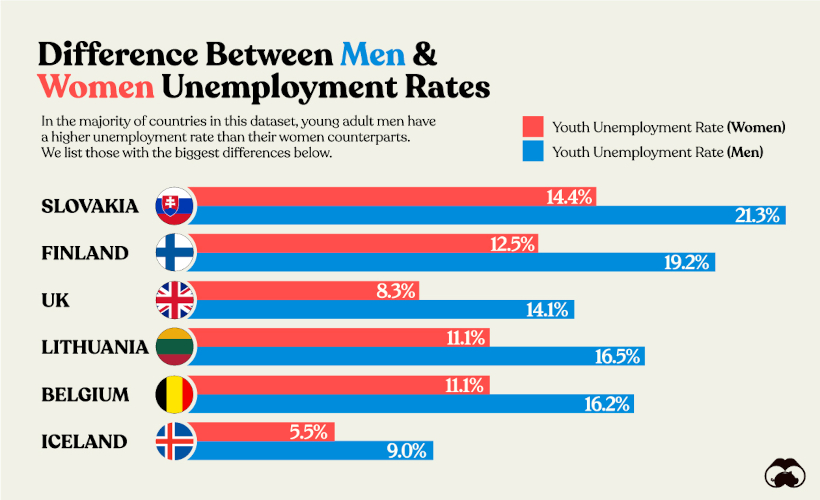
There is no singular reason that explains this common gap.
Across the OECD, more young women opt for tertiary education than young men, which may lead to better employment prospects. At the same time women are overrepresented in the health and social welfare sectors—both growing rapidly thanks to an aging population—that may make it easier for them to find jobs.
Why Does Tracking Youth Unemployment Matter?
Aside from being an indicator of general opportunities within a country, youth unemployment is a key metric to track, because it can be a bellwether for future economic prospects.
High rates of youth unemployment also correlate to brain drain within a country, as young adults move elsewhere to find better jobs.
Finally, large increases in unemployed youth have historically led to the potential of civil unrest, which makes it a politically-charged metric to identify and monitor for governments.
Where Does This Data Come From?
Sources: OECD Data and National Bureau of Statistics of China.
Note: China’s youth unemployment rate is for 16–24 year-olds. The OECD youth unemployment rate is for 15–24 year-olds.
China
Which Countries Have the Most Economic Influence in Southeast Asia?
One country dominates this survey of who has the most economic influence in the region.
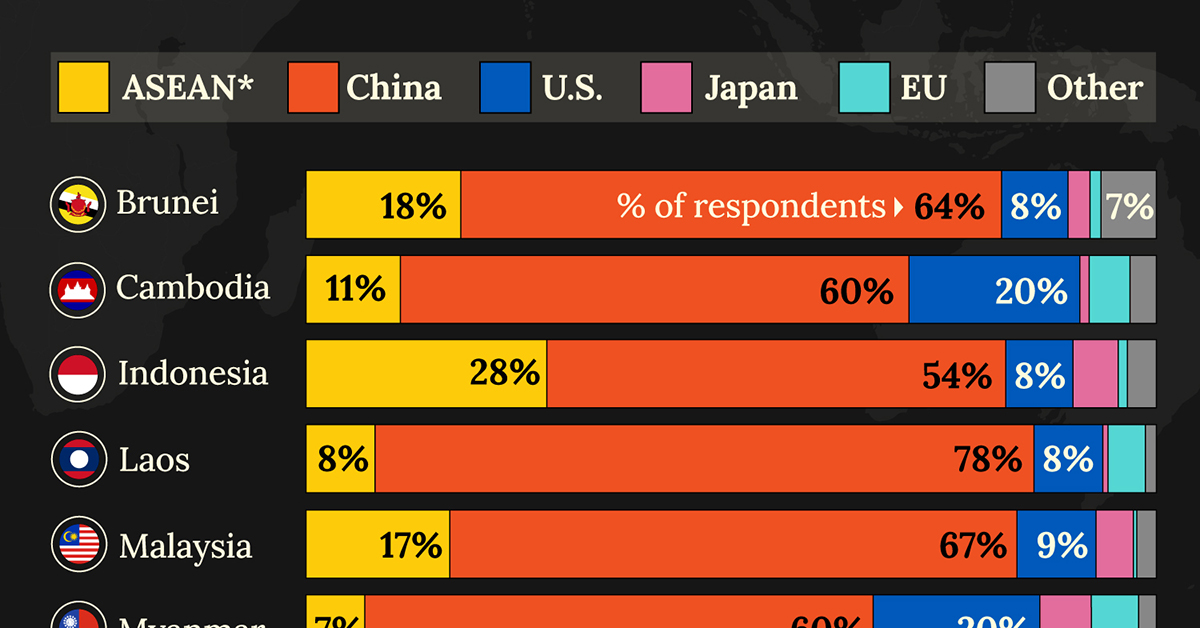
Countries With the Most Economic Influence in Southeast Asia
This was originally posted on our Voronoi app. Download the app for free on iOS or Android and discover incredible data-driven charts from a variety of trusted sources.
This chart visualizes the results of a 2024 survey conducted by the ASEAN Studies Centre at the ISEAS-Yusof Ishak Institute.
Nearly 2,000 respondents from 10 countries were asked to select which country/region they believe has the most influential economic power in Southeast Asia.
The countries surveyed are all member states of the Association of Southeast Asian Nations (ASEAN), a political and economic union of 10 countries in Southeast Asia.
Southeast Asia Perceptions: Who’s Got Economic Influence?
Across all ASEAN nations, China is regarded as the region’s most influential economic power.
Laos and Thailand had the highest share of respondents picking China, at 78% and 71% respectively. As the report points out, China is Laos’ largest foreign investor as well as its top export market.
| Country | 🇨🇳 China | 🌏 ASEAN | 🇺🇸 U.S. |
|---|---|---|---|
| 🇧🇳 Brunei | 64% | 18% | 8% |
| 🇰🇭 Cambodia | 60% | 11% | 20% |
| 🇮🇩 Indonesia | 54% | 28% | 8% |
| 🇱🇦 Laos | 78% | 8% | 8% |
| 🇲🇾 Malaysia | 67% | 17% | 9% |
| 🇲🇲 Myanmar | 60% | 7% | 20% |
| 🇵🇭 Philippines | 31% | 26% | 28% |
| 🇸🇬 Singapore | 60% | 15% | 21% |
| 🇹🇭 Thailand | 71% | 9% | 11% |
| 🇻🇳 Vietnam | 53% | 29% | 11% |
Note: Percentages are rounded.
Other ASEAN countries usually score highly as well, along with the United States.
It’s only in the Philippines, where China (31%), the U.S. (28%) and ASEAN (26%) were perceived as having a similar amount of influence.
ASEAN, Japan, and the EU
Filipinos also rated Japan’s economic influence the highest (9%) compared to those surveyed in other ASEAN countries. In 2023, the Southeast Asian bloc celebrated 50 years of friendship with Japan, marking it as one of their most important “dialogue partners.”
| Country | 🇯🇵 Japan | 🇪🇺 EU | 🌐 Other |
|---|---|---|---|
| 🇧🇳 Brunei | 3% | 1% | 7% |
| 🇰🇭 Cambodia | 1% | 5% | 3% |
| 🇮🇩 Indonesia | 5% | 1% | 3% |
| 🇱🇦 Laos | 1% | 4% | 1% |
| 🇲🇾 Malaysia | 4% | 0% | 2% |
| 🇲🇲 Myanmar | 6% | 6% | 2% |
| 🇵🇭 Philippines | 9% | 4% | 3% |
| 🇸🇬 Singapore | 3% | 0% | 2% |
| 🇹🇭 Thailand | 3% | 4% | 4% |
| 🇻🇳 Vietnam | 3% | 3% | 2% |
Note: Percentages are rounded. Other countries include: Australia, South Korea, India, and the UK.
The EU also received single-percentage responses, its highest share coming from Myanmar (6%), Cambodia (5%), and Laos (4%).
Finally, the report contrasted China’s robust economic influence with concerns about its growing impact in the region. Respondents from Vietnam (88%), Myanmar (88%), and Thailand (80%) had the highest levels of concern, despite their countries’ strong trade ties with China.
-
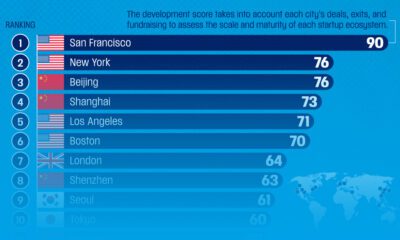
 Technology1 week ago
Technology1 week agoRanked: The Top Startup Cities Around the World
-
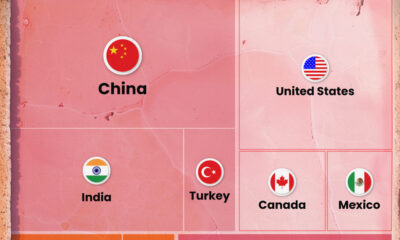
 Mining2 weeks ago
Mining2 weeks agoThe Biggest Salt Producing Countries in 2023
-

 Markets2 weeks ago
Markets2 weeks agoRanked: The Top 6 Economies by Share of Global GDP (1980-2024)
-
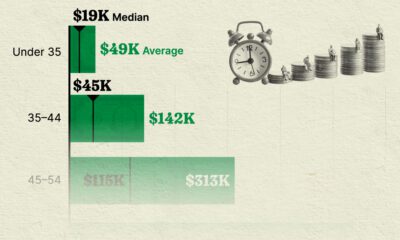
 Money2 weeks ago
Money2 weeks agoVisualizing America’s Average Retirement Savings, by Age
-
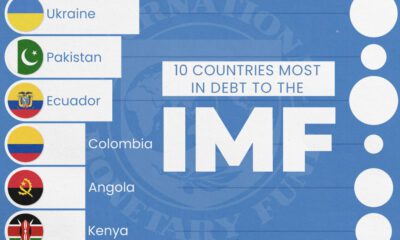
 Markets2 weeks ago
Markets2 weeks agoTop 10 Countries Most in Debt to the IMF
-
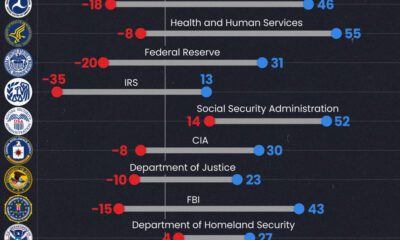
 United States2 weeks ago
United States2 weeks agoCharted: How Democrats and Republicans View Government Agencies
-

 Maps2 weeks ago
Maps2 weeks agoMapped: The Top Exports in Asian Countries
-
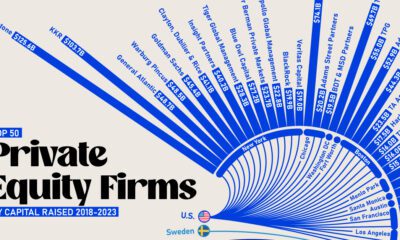
 Venture Capital2 weeks ago
Venture Capital2 weeks agoRanked: The World’s 50 Largest Private Equity Firms




